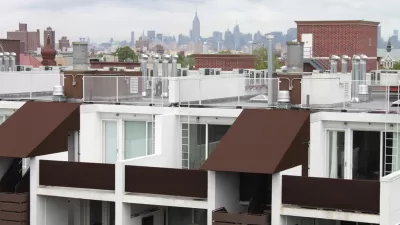With a surging homeless population, the city's cluster site program incentivizes slumlords and reduces the supply of affordable housing.

The cluster-site program, an emergency housing program for homeless New Yorkers, has been criticized as a dysfunctional shelter system, yet the 83-unit building at Clarkson Avenue, in the middle of a gentrifying Brooklyn neighborhood, represents "one of the most complex and intractable challenges confronting" New York City Mayor Bill DeBlasio, writes Vivan Yee for the New York Times.
The program, which pays for homeless people to live temporarily in privately owned buildings, began in 2000, when the homeless population was overwhelming city shelters. But with the city paying over $2,500 per month per family, the Clarkson Avenue building featured in Yee's story highlights the inefficiencies of a system wherein landlords stand to gain more from sheltering homeless people than by providing affordable housing for Section 8 voucher tenants and other low-income renters.
"Critics of the program, including advocates for homeless people, community leaders and elected officials, denounced it as a stopgap that papered over one problem only to worsen another, pushing low-income residents out of their homes and removing otherwise affordable apartments from circulation," reports Yee.
The program was supposed to be temporary, but the number of homeless people living in cluster-site buildings has steadily increased. The money designated to the program is also supposed to provide social services, including building security and employment assistance. However, conditions have deteriorated in these buildings. In one Ditmas Park building, "people loitered in the common areas, openly using drugs. Cockroaches clustered in the light fixture and refrigerator. Doors and windows were broken. The bathroom was moldy and pocked with rodent holes. There was no stove."
FULL STORY: Homeless Families Endure Roaches, Mice and Failed Promises

Alabama: Trump Terminates Settlements for Black Communities Harmed By Raw Sewage
Trump deemed the landmark civil rights agreement “illegal DEI and environmental justice policy.”

Planetizen Federal Action Tracker
A weekly monitor of how Trump’s orders and actions are impacting planners and planning in America.

The 120 Year Old Tiny Home Villages That Sheltered San Francisco’s Earthquake Refugees
More than a century ago, San Francisco mobilized to house thousands of residents displaced by the 1906 earthquake. Could their strategy offer a model for the present?

In Both Crashes and Crime, Public Transportation is Far Safer than Driving
Contrary to popular assumptions, public transportation has far lower crash and crime rates than automobile travel. For safer communities, improve and encourage transit travel.

Report: Zoning Reforms Should Complement Nashville’s Ambitious Transit Plan
Without reform, restrictive zoning codes will limit the impact of the city’s planned transit expansion and could exclude some of the residents who depend on transit the most.

Judge Orders Release of Frozen IRA, IIJA Funding
The decision is a victory for environmental groups who charged that freezing funds for critical infrastructure and disaster response programs caused “real and irreparable harm” to communities.
Urban Design for Planners 1: Software Tools
This six-course series explores essential urban design concepts using open source software and equips planners with the tools they need to participate fully in the urban design process.
Planning for Universal Design
Learn the tools for implementing Universal Design in planning regulations.
Clanton & Associates, Inc.
Jessamine County Fiscal Court
Institute for Housing and Urban Development Studies (IHS)
City of Grandview
Harvard GSD Executive Education
Toledo-Lucas County Plan Commissions
Salt Lake City
NYU Wagner Graduate School of Public Service





























